
Chinese is a group of languages spoken natively by the ethnic Han Chinese majority and many minority ethnic groups in China. Approximately 1.35 billion people, or around 16% of the global population, speak a variety of Chinese as their first language.

Mandarin is a group of Chinese language dialects that are natively spoken across most of northern and southwestern China. The group includes the Beijing dialect, the basis of the phonology of Standard Chinese, the official language of China. Because Mandarin originated in North China and most Mandarin dialects are found in the north, the group is sometimes referred to as Northern Chinese. Many varieties of Mandarin, such as those of the Southwest and the Lower Yangtze, are not mutually intelligible with the standard language. Nevertheless, Mandarin as a group is often placed first in lists of languages by number of native speakers.
Tone is the use of pitch in language to distinguish lexical or grammatical meaning—that is, to distinguish or to inflect words. All oral languages use pitch to express emotional and other para-linguistic information and to convey emphasis, contrast and other such features in what is called intonation, but not all languages use tones to distinguish words or their inflections, analogously to consonants and vowels. Languages that have this feature are called tonal languages; the distinctive tone patterns of such a language are sometimes called tonemes, by analogy with phoneme. Tonal languages are common in East and Southeast Asia, Africa, the Americas and the Pacific.
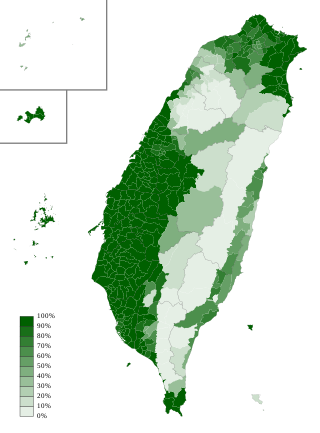
Taiwanese Hokkien, or simply Taiwanese, also known as Taiuanoe, Taigi, Taigu, Taiwanese Minnan, Hoklo and Holo, is a variety of the Hokkien language spoken natively by more than 70 percent of the population of Taiwan. It is spoken by a significant portion of those Taiwanese people who are descended from Hoklo immigrants of southern Fujian. It is one of the national languages of Taiwan.
Sandhi is a cover term for a wide variety of sound changes that occur at morpheme or word boundaries. Examples include fusion of sounds across word boundaries and the alteration of one sound depending on nearby sounds or the grammatical function of the adjacent words. Sandhi belongs to morphophonology.

Penang Hokkien is a local variant of Hokkien spoken in Penang, Malaysia. It is spoken natively by 63.9% of Penang's Chinese community, and also by some Penangite Indians and Penangite Malays.
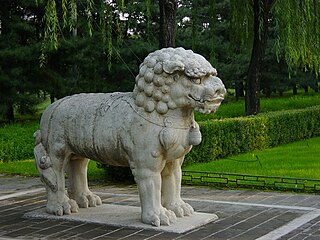
"Lion-Eating Poet in the Stone Den" is a short narrative poem written in Literary Chinese that is composed of about 94 characters in which every word is pronounced shi when read in modern Standard Chinese, a dialect based on the Mandarin Chinese spoken in Beijing, with only the tones differing.
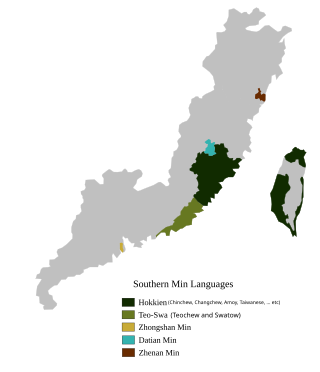
Teochew, also known as Teo-Swa, is a Southern Min language spoken by the Teochew people in the Chaoshan region of eastern Guangdong and by their diaspora around the world. It is sometimes referred to as Chiuchow, its Cantonese rendering, due to English romanization by colonial officials and explorers. It is closely related to Hokkien, as it shares some cognates and phonology with Hokkien.
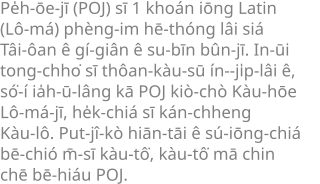
Pe̍h-ōe-jī, sometimes known as Church Romanization, is an orthography used to write variants of Hokkien Southern Min, particularly Taiwanese and Amoy Hokkien, and it is widely employed as one of the writing systems for Southern Min. During its peak, it had hundreds of thousands of readers.

The Fuzhou language, also Foochow, Hokchew, Hok-chiu, or Fuzhounese, is the prestige variety of the Eastern Min branch of Min Chinese spoken mainly in the Mindong region of Eastern Fujian Province. As it is mutually unintelligible to neighbouring varieties in the province, under a technical linguistic definition Fuzhou is a language and not a dialect. Thus, while Fuzhou may be commonly referred to as a 'dialect' by laypersons, this is colloquial usage and not recognised in academic linguistics. Like many other varieties of Chinese, the Fuzhou dialect is dominated by monosyllabic morphemes that carry lexical tones, and has a mainly analytic syntax. While the Eastern Min branch it belongs to is relatively closer to other branches of Min such as Southern Min or Pu-Xian Min than to other Sinitic branches such as Mandarin, Wu Chinese or Hakka, they are still not mutually intelligible.
This article describes the phonology of the Somali language.
A checked tone, commonly known by the Chinese calque entering tone, is one of the four syllable types in the phonology of Middle Chinese. Although usually translated as "tone", a checked tone is not a tone in the phonetic sense but rather a syllable that ends in a stop consonant or a glottal stop. Separating the checked tone allows -p, -t, and -k to be treated as allophones of -m, -n, and -ng, respectively, since they are in complementary distribution. Stops appear only in the checked tone, and nasals appear only in the other tones. Because of the origin of tone in Chinese, the number of tones found in such syllables is smaller than the number of tones in other syllables. Chinese phonetics have traditionally counted them separately.
Tone numbers are numerical digits used like letters to mark the tones of a language. The number is usually placed after a romanized syllable. Tone numbers are defined for a particular language, so they have little meaning between languages.
Wenzhounese, also known as Oujiang, Tong Au or Au Nyü, is the language spoken in Wenzhou, the southern prefecture of Zhejiang, China. It is the most divergent division of Wu Chinese, with little to no mutual intelligibility with other Wu dialects or any other variety of Chinese. It features noticeable elements in common with Min Chinese, which is spoken to the south in Fujian. Oujiang is sometimes used as the broader term, and Wenzhou for Wenzhounese proper in a narrow sense.

The Amoy dialect or Xiamen dialect, also known as Amoyese, Amoynese, Amoy Hokkien, Xiamenese or Xiamen Hokkien, is a dialect of Hokkien spoken in the city of Xiamen and its surrounding metropolitan area, in the southern part of Fujian province. Currently, it is one of the most widely researched and studied varieties of Southern Min. It has historically come to be one of the more standardized varieties.
Cantonese changed tones occur when a word's tone becomes a different tone due to a particular context or meaning. A "changed" tone is the tone of the word when it is read in a particular lexical or grammatical context, while the base tone is usually the tone of the word when read in citation. It is thus distinct from tone sandhi, which are automatic modifications of tone created by their phonetic environment, without regard to meaning. In its most common form, it occurs on the final syllable of either a compound word, a reduplicated word, or certain vocative examples, especially in direct address to people such as family members. There are a limited set of semantic domains where changed tone occurs, generally associated with small things, familiarity, food and disease.
Tone letters are letters that represent the tones of a language, most commonly in languages with contour tones.
The phonology of Standard Chinese has historically derived from the Beijing dialect of Mandarin. However, pronunciation varies widely among speakers, who may introduce elements of their local varieties. Television and radio announcers are chosen for their ability to affect a standard accent. Elements of the sound system include not only the segments—e.g. vowels and consonants—of the language, but also the tones applied to each syllable. In addition to its four main tones, Standard Chinese has a neutral tone that appears on weak syllables.
Daī-ghî tōng-iōng pīng-im is an orthography in the Latin alphabet for Taiwanese Hokkien based upon Tongyong Pinyin. It is able to use the Latin alphabet to indicate the proper variation of pitch with nine diacritic symbols.
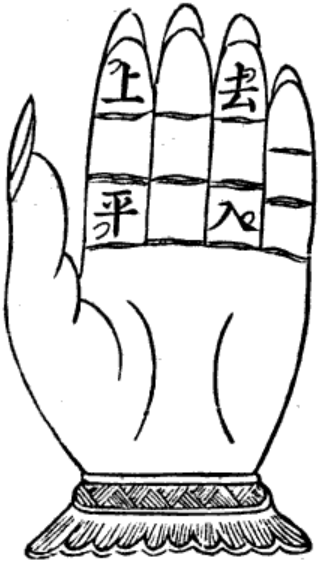
The four tones of Chinese poetry and dialectology are four traditional tone classes of Chinese words. They play an important role in Chinese poetry and in comparative studies of tonal development in the modern varieties of Chinese, both in traditional Chinese and in Western linguistics. They correspond to the phonology of Middle Chinese, and are named even or level, rising, departing or going, and entering or checked. They are reconstructed as mid, mid rising, high falling, and mid with a final stop consonant respectively. Due to historic splits and mergers, none of the modern varieties of Chinese have the exact four tones of Middle Chinese, but they are noted in rhyming dictionaries.










